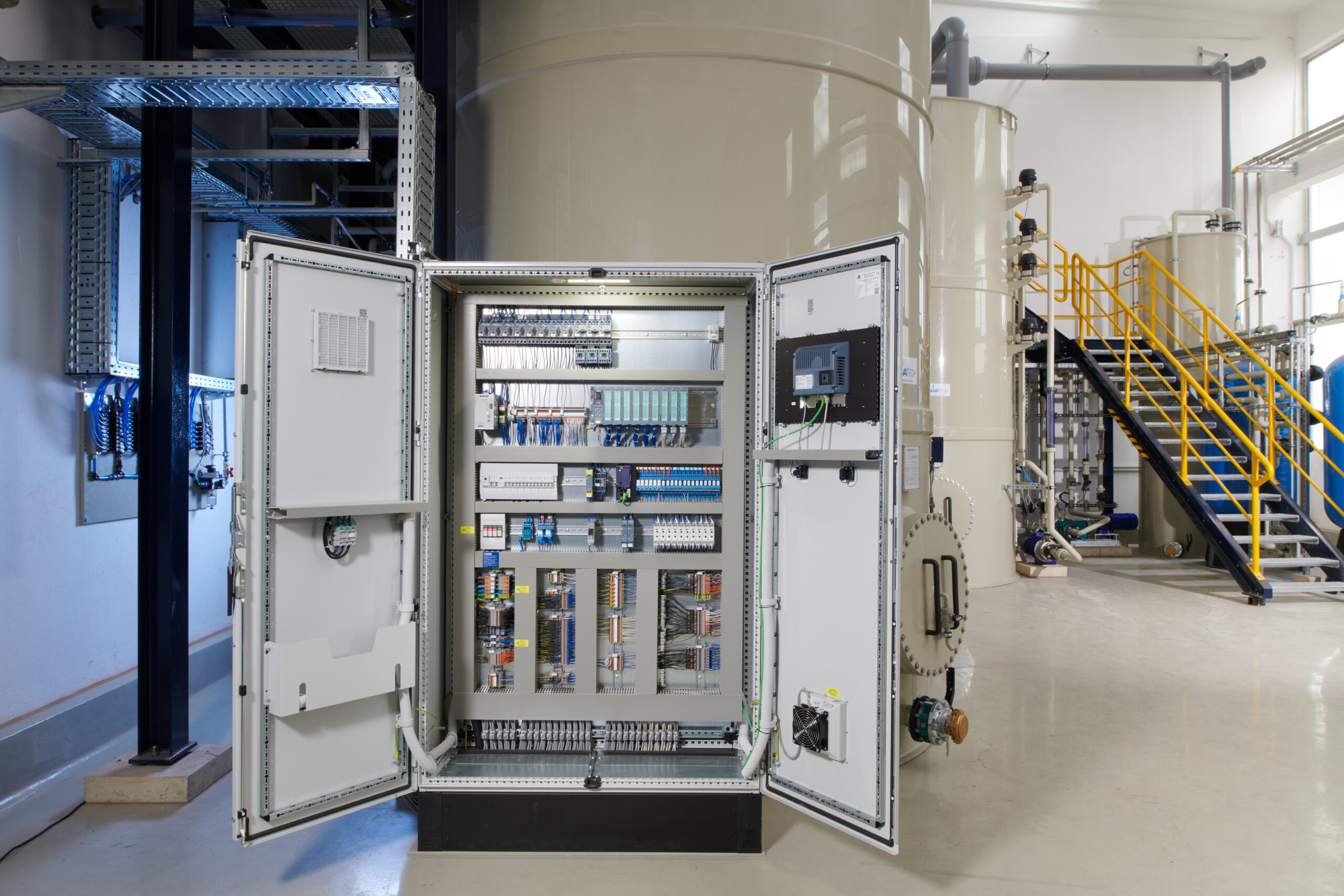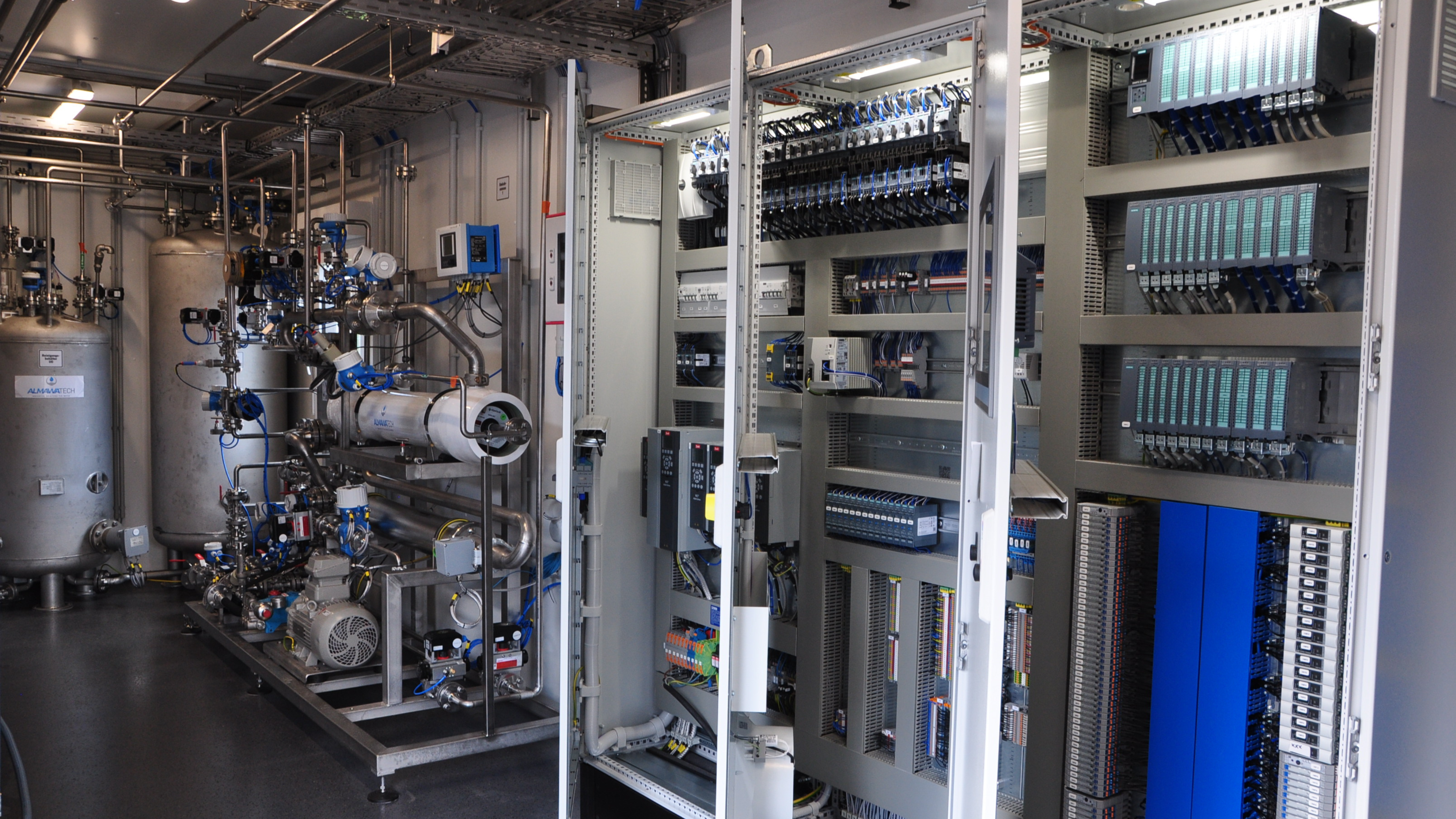A contactor is an electromagnetically controlled switch that is used in control technology and automation to switch electrical loads such as pumps, motors, heaters or ventilators on and off. In water and wastewater technology, the contactor is a central component in switchgear, as it enables reliable and fast control of electrical systems.
Table of contents
Structure of a contactor
A contactor consists of several functional components that are precisely matched to each other in order to switch electrical loads safely. The most important components are
Solenoid coil:
- Converts electrical energy into mechanical movement.
- Operated by direct or alternating current (depending on the version).
Anchor:
- Moving part that is attracted by the magnetic field of the coil and closes the main contacts.
Main contacts:
- Contacts that enable the flow of current to the load (e.g. pump).
- Designed for high currents and switching cycles.
Auxiliary contacts:
- Smaller contacts that perform control functions, such as activating signal lights or providing feedback on the switching status.
Housing:
- Protection against environmental influences and electrical contact.
- Often consists of thermoplastic or thermosetting plastic.
Spring mechanism:
- Resets the armature to its initial state when the solenoid coil is no longer active.
Functionality of the contactor
The contactor works according to the principle of electromagnetic attraction. The process can be divided into three steps:
Dressing:
- When a voltage is applied to the coil, a magnetic field is generated.
- This magnetic field attracts the armature, which closes the main contacts and starts the current flow to the load.
Holding state:
- As long as the coil is energized, the armature remains attracted by the magnetic field.
- The electrical current flows through the load (e.g. a pump or an aerator).
Reset:
- As soon as the voltage to the coil is switched off, the magnetic field disappears.
- A return spring moves the armature to the starting position, which opens the main contacts and interrupts the current flow.

Photo: Our switchgear for the ALMA CHEM MCW CP system
Technical parameters of contactors
Rated voltage and current:
- Contactors are designed for specific voltages (e.g. 24 V DC, 230 V AC, 400 V AC) and currents.
- Typical applications in water technology require contactors with a current carrying capacity of 10 A to over 100 A.
Switching capacity:
- Defines which power the contactor can switch safely.
- Classification in AC1 to AC4:
- AC1: Non-inductive or weakly inductive loads (e.g. heaters).
- AC3: Inductive loads such as electric motors.
Switching cycles:
- Number of switching cycles that a contactor can safely perform under full load.
- Industrial contactors are designed for up to 10 million switching cycles.
Switching speed:
- Time span between applying the coil voltage and closing the main contacts (typically: 10-50 ms).
Ambient temperature:
- Contactors are usually designed for operating temperatures between -20 °C and +60 °C.
Areas of application for contactors in water and wastewater technology
Contactors play a central role in the automation and control of water technology systems:
1. control of pumps
- Contactors switch the main drive motors in pumping stations and sewage treatment plants.
- Advantages:
- High reliability with frequent switching operations.
- Protection against overload through combination with overload relay.
2. control of ventilation systems
- In aerobic biological treatment plants, contactors are used to switch blowers and aerators as required.
- Switching cycles can be triggered by signals from oxygen sensors or control units.
3. switching of heating systems
- Contactors control heaters in precipitation reactors to keep chemical processes at the optimum temperature.
4. automated control systems in membrane systems
- In reverse osmosis and nanofiltration systems, contactors switch high-pressure pumps and valves.
5. cooling water and boiler circuits
- Contactors control the circulation pumps that ensure temperature control in cooling circuits and boilers.
Advantages of contactors
Reliability:
- Long service life and high switching cycles ensure trouble-free operation.
Simple control:
- Compatible with automation systems such as PLCs (programmable logic controllers).
Overload protection:
- In combination with protective relays or fuses, contactors offer comprehensive protection against overloads and short circuits.
Flexibility:
- Large selection of voltages and currents for different applications.
Security:
- Electrical isolation between the control and load circuits reduces the risk of short circuits and overvoltages.

Photo: Our switchgear for the ALMA OSMO reverse osmosis system. The motor contactors in the switch cabinet are clearly visible
Challenges and maintenance
Contact erosion
- Cause:
- Arcing when opening the contacts.
- Solution:
- Use of silver-cadmium oxide contacts to reduce combustion.
- Regularly check and clean the contacts.
Overheating
- Cause:
- Permanent overload or poor contact.
- Solution:
- Use of overload relays and correct dimensioning of the contactor.
Mechanical wear
- Cause:
- Frequent switching cycles.
- Solution:
- Replace the contactor once the maximum switching cycles have been reached.
Optimization options with modern contactors
Energy-efficient coils
- Use of electronically controlled coils reduces energy consumption.
Smart contactor
- Integration into digital control systems enables the monitoring of operating states and predictive maintenance.
Combination with frequency inverters
- Contactors work together with frequency converters to optimize motor control and minimize energy losses.
Conclusion
A contactor is an indispensable component in control technology for water and wastewater treatment. With its ability to safely switch high currents, it plays a key role in the automation of industrial processes. Through the targeted use of contactors, systems can be operated efficiently, reliably and safely. Regular maintenance and the use of modern, energy-efficient coils help to further optimize operation and extend the service life of the systems.
For further information on our products, please feel free to contact us at any time!








